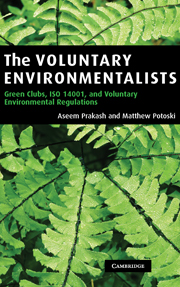Book contents
- Frontmatter
- Contents
- List of figures
- List of tables
- Preface
- Acknowledgements
- 1 Introduction
- 2 Green clubs: an institutionalist perspective
- 3 ISO 14001 and voluntary programs
- 4 Adopting ISO 14001
- 5 ISO 14001 and firms' environmental and regulatory performance
- 6 Conclusions and future directions
- References
- Name Index
- Subject Index
5 - ISO 14001 and firms' environmental and regulatory performance
Published online by Cambridge University Press: 10 December 2009
- Frontmatter
- Contents
- List of figures
- List of tables
- Preface
- Acknowledgements
- 1 Introduction
- 2 Green clubs: an institutionalist perspective
- 3 ISO 14001 and voluntary programs
- 4 Adopting ISO 14001
- 5 ISO 14001 and firms' environmental and regulatory performance
- 6 Conclusions and future directions
- References
- Name Index
- Subject Index
Summary
The ultimate test of a voluntary program, or any policy instrument for that matter, is whether the program induces participants to change their behavior in ways the program desires. An effective green club, one that induces participants to take progressive action beyond what they would take unilaterally, requires a few important conditions, as we discussed in chapter 2. First, the program must impose some non-trivial membership costs because the environmental protection the club looks to induce from its members is not free. Second, the program must provide some non-trivial excludable benefit to induce firms to take on the costs of joining the club. For green clubs, the excludable benefit is generally the goodwill that accrues to participants as a consequence of their membership in the program. The excludable benefit induces some firms that would otherwise have lower environmental performance than the club requires to take on the additional cost of membership and produce the program's targeted public goods. Finally, an effective voluntary environmental program must have a monitoring and enforcement mechanism that ensures members comply with the program standards once they have joined.
In chapter 3 we outlined how these features apply to ISO 14001. We showed that joining ISO 14001 carries important costs in terms of paying for the external audits, adopting and maintaining a stringent EMS, and so on. In chapters 3 and 4 we discussed how ISO 14001 offers an important brand name that carries value with government regulators and other important stakeholders.
- Type
- Chapter
- Information
- The Voluntary EnvironmentalistsGreen Clubs, ISO 14001, and Voluntary Environmental Regulations, pp. 146 - 170Publisher: Cambridge University PressPrint publication year: 2006



